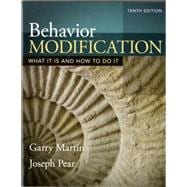A balanced presentation of the principles and tactics of behavior modification
Behavior Modification: What It Is and How to Do It, 10/e assumes no specific prior knowledge about psychology or behavior modification on the part of the reader. The authors begin with basic principles and procedures of behavior modification and then provide readers with how-to-skills such as observing and recording. Next, the authors provide advanced discussion and references to acquaint readers with some of the empirical and theoretical underpinnings of the field. Readers will emerge with a thorough understanding of behavior modification in a wide variety of populations and settings.








